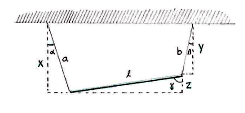Solution 4.2:8
From Förberedande kurs i matematik 1
m (Lösning 4.2:8 moved to Solution 4.2:8: Robot: moved page) |
|||
| Line 1: | Line 1: | ||
| - | + | We start by drawing three auxiliary triangles, and calling the three vertical sides | |
| - | < | + | <math>x,\ y</math> |
| - | + | and | |
| - | + | <math>z</math>, as shown in the figure. | |
| - | < | + | |
| - | + | ||
[[Image:4_2_8.gif|center]] | [[Image:4_2_8.gif|center]] | ||
| + | |||
| + | Using the definition of cosine, we can work out | ||
| + | <math>x\text{ }</math> | ||
| + | and | ||
| + | <math>y</math> | ||
| + | from | ||
| + | |||
| + | |||
| + | <math>x=a\cos \alpha </math> | ||
| + | |||
| + | |||
| + | <math>y=b\cos \beta </math> | ||
| + | |||
| + | and, for the same reason, we know that | ||
| + | <math>z\text{ }</math> | ||
| + | satisfies the relation | ||
| + | |||
| + | |||
| + | <math>z=l\cos \gamma </math> | ||
| + | |||
| + | |||
| + | In addition, we know that the lengths | ||
| + | <math>x,\ y</math> | ||
| + | and | ||
| + | <math>z</math> | ||
| + | satisfy the equality | ||
| + | |||
| + | |||
| + | <math>z=x-y</math> | ||
| + | |||
| + | |||
| + | If we substitute in the expressions for | ||
| + | <math>x,\ y</math> | ||
| + | and | ||
| + | <math>z</math>, we obtain the trigonometric equation | ||
| + | |||
| + | |||
| + | <math>l\cos \gamma =a\cos \alpha -b\cos \beta </math> | ||
| + | |||
| + | |||
| + | where | ||
| + | <math>\gamma </math> | ||
| + | is the only unknown. | ||
Revision as of 09:40, 29 September 2008
We start by drawing three auxiliary triangles, and calling the three vertical sides \displaystyle x,\ y and \displaystyle z, as shown in the figure.
Using the definition of cosine, we can work out \displaystyle x\text{ } and \displaystyle y from
\displaystyle x=a\cos \alpha
\displaystyle y=b\cos \beta
and, for the same reason, we know that \displaystyle z\text{ } satisfies the relation
\displaystyle z=l\cos \gamma
In addition, we know that the lengths
\displaystyle x,\ y
and
\displaystyle z
satisfy the equality
\displaystyle z=x-y
If we substitute in the expressions for
\displaystyle x,\ y
and
\displaystyle z, we obtain the trigonometric equation
\displaystyle l\cos \gamma =a\cos \alpha -b\cos \beta
where
\displaystyle \gamma
is the only unknown.

